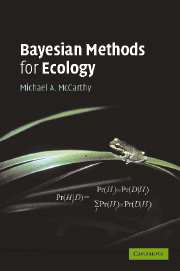4 - How good are the models?
Published online by Cambridge University Press: 05 June 2012
Summary
Statistical analyses rely on models that approximate reality. For example, when analysing a mean, it is usually assumed that the data are drawn from a particular probability distribution. Such probability distributions are unlikely to emulate perfectly the real processes that generated the data. Because models are imperfect, ecologists need to consider both how well a model approximates reality, and also how well different models perform relative to each other.
There is a range of approaches to evaluating data and models. Exploratory data analysis uses graphs to detect outliers and errors, and illustrate trends prior to formal analysis (Tukey, 1997; Ellison, 2001; Quinn and Keough, 2002; Gotelli and Ellison, 2004). As part of the formal analysis, it is necessary to assess the various assumptions of the statistical model that is being used, and how well the model fits the data. Analyses of residuals, influence diagrams, probability plots, and other diagnostic methods are available for assessing the model's assumptions (Sokal and Rohlf, 1995; Quinn and Keough, 2002; Gotelli and Ellison, 2004). R-squared (R2) values are commonly used by ecologists to determine how well a statistical model fits the data, but other measures are used for some types of analyses (e.g. ROC, Kappa values, probability plots, Quinn and Keough, 2002; Wintle et al., 2005b). All these aspects of model evaluation are important, but I do not deal with them here because they are not uniquely Bayesian.
- Type
- Chapter
- Information
- Bayesian Methods for Ecology , pp. 94 - 118Publisher: Cambridge University PressPrint publication year: 2007



